Uppsala University
Uppsala universitet | |
University town | |
| Colours | Maroon, white |
|---|---|
| Affiliations | Coimbra Group EUA Matariki Network of Universities Guild of European Research-Intensive Universities |
| Website | uu.se (in Swedish) |
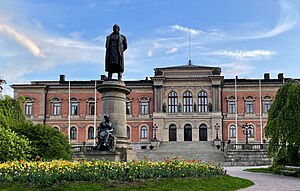
Uppsala University (UU) (
Initially founded in the 15th century, the university rose to significance during the rise of
Uppsala belongs to the Coimbra Group of European universities and to the Guild of European Research-Intensive Universities.[5] It has ranked among the world's 100 best universities in several international rankings.[6][7][8]
The university has nine faculties distributed over three disciplinary domains: Humanities and Social Sciences, Medicine and Pharmacy, and Science and Technology. As of 2020[update], it had approximately 52,000 registered students at the undergraduate and postgraduate levels and 2,200 PhD students.[2]
Architecturally, Uppsala University has traditionally had a strong presence in Fjärdingen, the neighbourhood around the cathedral on the western side of the river Fyris. Despite some contemporary building developments further away from the centre, Uppsala's historic centre continues to be dominated by the presence of the university.[9]
History
15th century: Origins
As with most medieval universities, Uppsala University initially grew out of an ecclesiastical centre.
16th century: Turbulent times
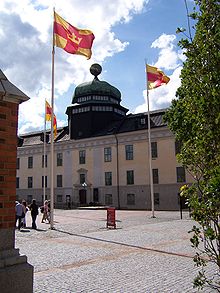
The turbulent period of the reformation of King
Theology still had precedence, but in the privileges of 1593, the importance of a university to educate secular servants of the state was also emphasized. Three of the seven professorial chairs which were established were in Theology; of the other four, three were in Astronomy, Physics (or general natural sciences) and Latin eloquence. A fourth chair was given to Ericus Jacobi Skinnerus, who was also appointed rector, but whose discipline was not mentioned in the charter. Of the professors, several were taken over from the Collegium regium Stockolmense in Stockholm, which had been functioning for a few years but closed in 1593. An eighth chair, in Medicine, was established in 1595 but received no appointee for several years. In 1599 the number of students was approximately 150. In 1600 the first post-reformation conferment of degrees took place. In the same year, the antiquarian and mystic Johannes Bureus designed and engraved the seal of the university, which is today used as part of the logotype.
17th century: Expansion
The medieval university had mainly been a theology school. The aspirations of the emergent new great power of Sweden demanded a different kind of learning.
Instrumental in the reforms of the early 17th-century Swedish state was the long-dominant Chancellor
During the late 16th and early 17th centuries (and perhaps even earlier), the university was located in the old chapter house parallel to the south side of the cathedral, later renamed the Academia Carolina. In 1622–1625 a new university building was built east of the cathedral, the so-called Gustavianum, named after the reigning king. In the 1630s, the total number of students was about one thousand.
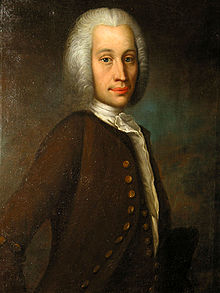
Queen Christina was generous to the university, gave scholarships to Swedish students to study abroad and recruited foreign scholars to Uppsala chairs, among them several from the University of Strasbourg, notably, the philologist Johannes Schefferus (professor Skytteanus), whose little library and museum building at St Eriks torg now belongs to the Royal Society of Sciences in Uppsala. The Queen, who would eventually declare her abdication in the great hall of Uppsala Castle, visited the university on many occasions; in 1652 she was present at an anatomical demonstration arranged at the castle for the young physician Olaus Rudbeck. Rudbeck, one of several sons of Johannes Rudbeckius, a former Uppsala professor who became Bishop of Västerås, was sent for a year to the progressive Leiden University in the Netherlands. Returning in 1654, he received an assistantship in Medicine 1655 and had already gone to work on a program for improving aspects of the university. He planted the first botanical garden, the one which would eventually be tended by Carl Linnaeus and is kept today as a museum of 18th-century botany under the name Linnéträdgården ("the Linnaean Garden"). With the patronage of the university chancellor Magnus Gabriel De la Gardie, Rudbeck was made full professor in 1660, was elected rector for two terms, despite his youth, and started a revision of the work of the other professors and a building spree with himself as an architect. His most significant remaining architectural work is the anatomical theatre, which was added to Gustavianum in the 1660s and crowned with the characteristic cupola for which the building is today known.
A gifted scientist, architect and engineer, Rudbeck was the dominant personality of the university in the late 17th century who laid some of the groundwork for Linnaeus and others, but he is perhaps more known today for the pseudohistorical speculations of his Atlantica, which consumed much of his later life. When large parts of Uppsala burned down in 1702, Gustavianum, which contained the university library and its many valuable manuscripts, escaped the fire; local lore has it that the ageing Rudbeck stood on the roof directing the work of fighting the fire.
18th century: Enlightenment and mercantilism
The early part of the 18th century was still characterized by the combination of Lutheran orthodoxy and classical philology of the previous century, but eventually, a larger emphasis on sciences and practically useful knowledge developed. The innovative mathematician and physicist
There were very radical attempts at reforms which were never implemented, but important changes took place. University studies had until this time been very informal in their overall organization, with the all-purpose philosophiæ magister-degree being the only one frequently conferred and many never graduating, as there was no degree applicable to their intended area of work (and well-connected aristocratic students often not graduating as they did not need to). A few professional degrees for various purposes were introduced in 1749–1750, but the radical suggestion of binding students to a single program of study adapted to a particular profession was never implemented. The reforms of this era have been compared to those of the 1960s and 1970s (Sten Lindroth).
Although it took some time after the fire of 1702, Uppsala Cathedral and Uppsala Castle were both eventually restored, both by Carl Hårleman, perhaps the most important Swedish architect of the era. He also modified Gustavianum, designed a new conservatory for Linnaeus' botanical garden and built the new Consistory house, which was to be the administrative core of the university.
Another magnificent royal donation was that of the large baroque garden of the castle, given by Gustav III to the university when it was obvious that the old botanical garden was insufficient. A large new conservatory was built by the architect Louis Jean Desprez. Additional grounds adjacent to the baroque garden have since been added. The old garden of Rudbeck and Linnaeus was largely left to decay but was reconstructed in the years between 1918 and 1923 according to the specifications of Linnaeus in his work Hortus Upsaliensis from 1745.
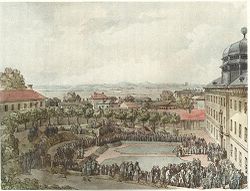
Women at the university
The issue of women's right to study at universities was raised during the very last session of the estate parliament in 1865 in a motion from Carl Johan Svensén, a member of the farmers' estate. The reception was mixed, with the most negative views coming from the clergy. In the following years, the issue continued to be debated at the universities. In 1870, it was decided to let women take the secondary school examination ("studentexamen") that gave the right to entry at universities and the right to study and complete degrees at the faculties of Medicine in Uppsala and Lund and at the Karolinska Institute in Stockholm. A common view was that female sensitivity and compassion would make women capable of working as physicians, but their right to work was still restricted to private practice. Women's rights to higher education were extended in 1873 when all degrees except those in the faculties of theology and the licentiate degree in Law were made accessible for women.
The first female student in Sweden was Betty Pettersson (1838–1885), who had already worked as a private tutor for several years when she took "studentexamen" in 1871. With a royal dispensation, she was allowed to enter university in Uppsala in 1872, the year before studies at the Philosophical faculty would actually be made generally available to women. She studied modern European languages and was the first woman in Sweden to complete an academic degree when she finished a film. kand. in 1875. She became the first woman to be employed as a teacher in a public school for boys. The first woman in Sweden to complete a doctoral degree was Ellen Fries (1855–1900), who entered Uppsala university in 1877 and became a PhD in history in 1883. Other female students of this period include Lydia Wahlström (1869–1954) who later became a noted educator, activist and writer on women's emancipation and suffrage. Defending a dissertation in history in 1900, she became the second woman to finish a doctorate at a Swedish university. In 1892, she founded the Uppsala Women's Student Association, which set up spex performances and other things enjoyed by male students but from which the women were excluded at the time. The members of the Association were the first woman to wear student caps in public, an important sign of their status. Elsa Eschelsson (1861–1911) was the first Swedish woman to finish a law degree and the first to become a "docent," but was not permitted to even hold the position of acting professor despite being formally qualified for this in everything but her sex. After years of conflicts with the professor of civil law A. O. Winroth, who wrote the paper on "Om tjenstehjonsförhållandet" and with the university board, she died in 1911 from an overdose of sleeping powder.
According to the constitution of 1809, only "native Swedish men" could be appointed to higher civil servant positions, including professorships. This was changed in 1925, and the first woman to hold a professorial chair at Uppsala University was Gerd Enequist, appointed professor of human geography in 1949.
Hildegard Björck who studied at the university became the first Swedish woman to receive an academic degree.
Administration and organisation
Central administration
The governing board of the university is the
The unions active at the university also have three representatives in the consistory; these members have the right to speak but not any right to vote.
Since the last reorganization in 1999, the university has had a separate body called the academic senate, which is a wider, but mostly advisory group representing teaching staff/researchers and students. The executive head of the university is the rector magnificus, whose deputy is the prorector. There are (also since 1999) three vice rectors, each heading one of the three "disciplinary domains" (Arts and Social Sciences, Medicine and Pharmacy, and Science and Technology) into which the nine faculties are divided. Each faculty has a faculty board and is headed by a dean (dekanus). The position of dean is held part-time by a professor of the faculty.
Faculties
Through the division of faculties and the addition of a previously independent school of Pharmacy as a new faculty, the traditional four-faculty organization of European universities has evolved into the present nine faculties. The disciplinary domains and their faculties are as depicted below.[14][15]
Disciplinary Domain of Arts and Social Sciences
- Faculty of Arts
- Faculty of Social Sciences
- Faculty of Languages
- Faculty of Theology
- Faculty of Law (Juridiska fakulteten) is the oldest law faculty in the Nordic countries and existed prior to the university's founding in 1477. The activities of the faculty include a wide range of research areas and specializations. This Faculty has one department: the Department of Law.[16]
- Faculty of Educational Sciences (formerly the Department of Education, and was raised to the status of a faculty in its own right in 2002)
Disciplinary Domain of Medicine and Pharmacy
- Faculty of Medicine
- Faculty of Pharmacy, originally an independent "royal institute" in Stockholm, which was moved to Uppsala and incorporated with the university between 1968 and 1972.
Disciplinary Domain of Science and Technology
- Faculty of Science and Technology: The engineering programs have since 1982 been marketed as the Uppsala School of Engineering (Uppsala Tekniska Högskola). This has however never been a separate institution. Still, only a unit within the Faculty of Science and Technology and the use of the term has been phased out after the Faculty of Mathematics and Natural Sciences was renamed the Faculty of Sciences and Technology in the 1990s.
Other
Uppsala University also hosts the Forum for South Asia Studies, a collaborative academic effort by its six faculties: Theology, Law, History and Philosophy, Social Sciences, Languages, and Educational Sciences. The Forum aims to facilitate and promote research and education related to the South Asian countries: India, Pakistan, Sri Lanka, Nepal, Bangladesh, Maldives and Afghanistan, on the national and international level, with Ferdinando Sardella, Faculty of Theology, serving as the Forum's director.[17]
University Library

The university library holds about 5.25 million volumes of books and periodicals (131,293 shelf meters), 61,959 manuscripts, 7,133 music prints, and 345,734 maps and other graphic documents. The holdings of the collection of manuscripts and music include, among other things, the Gothic Bible manuscript Codex Argenteus.
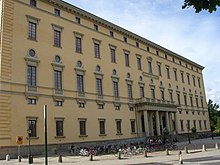
The most widely recognized building of the
The present university library system comprises 19 branches, including the one in the Carolina building.
Uppsala University Hospital
The Uppsala Academic Hospital or Akademiska sjukhuset, which functions as a teaching hospital for the Faculty of Medicine and the Nursing School, is run by the Uppsala County Council in cooperation with the university. As of 2003[update], the hospital had 7,719 employees and as of 2004[update] 1,079 places for patients.
The university hospital is actually older than the university, as it goes back to the earliest hospital, founded in Uppsala in 1302, and much later merged with the university clinic. This was used for 400 years until the great fire of 1702 which destroyed large parts of central Uppsala. A new hospital, which later became the Uppsala county hospital, was built in its place but was moved out of the town in 1811.

The first clinic with the specific intention to facilitate the practical education of medical students was the Nosocomium Academicum, founded in 1708 and located at the Oxenstierna Palace at Riddartorget beside the cathedral (see illustration above). The building (the former residence of the president of the Royal Chancellery Bengt Gabrielsson Oxenstierna) today houses the Faculty of Law.
The present Akademiska sjukhuset was founded in 1850 as an organizational merger of the county hospital and the university clinic, and a new building was inaugurated in 1867 on the hill below Uppsala Castle to the southeast. From this building, which is still in use, the present hospital complex has grown.
The Svedberg Laboratory
The Svedberg Laboratory (named after Theodor Svedberg) is a university facility that contains the Gustaf Werner cyclotron,[18] which is used for research as well as for proton therapy for the treatment of cancer with close cooperation with the oncology clinic at Uppsala University Hospital.[19] Such an accelerator and its gantries costs between $60 million and $100 million,[20] and makes Uppsala University Hospital one of the approximately 40 centres in the world to provide such cancer treatment.
Campus
The buildings and locations where the university has activities or which are significantly connected to its history are listed below. Some of the historic buildings in central Uppsala have had to be retired, as their protected status has made it impossible to make modifications necessary to meet requirements to adjust to the needs of students with disabilities.

University Park and Cathedral area
- Gustavianum
- Old Consistory building
- University Hall
- Ekerman House
- The Dean's House (or Julinsköld Palace)
- Skytteanum
- Oxenstierna House (Juridicum – Faculty of Law)
- Regnellianum
- Carolina Rediviva
West of central Uppsala
- English Park Campus – Centre for the Humanities (including the Centre for Language Studies)
- Museum of Evolution
- Botanical Garden
- Segerstedt Building – administrative building
- Blåsenhus – Centre for pedagogy, didactics, educational studies and psychology (former location for pedagogical studies was at Seminariehuset in the north of Uppsala)
Other locations in wider central Uppsala
- Theatrum Oeconomicum and Gamla Torget ("The Old Forum")
- The Observatory Park with the old observatory
- Ekonomikum
- The Linnaeus Garden
- Anders Celsius's former house and observatory
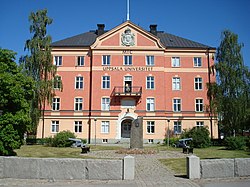
South of central Uppsala
- Uppsala University Hospital
- The Rudbeck Laboratory
- Uppsala Biomedical Centre (BMC)
- Geocentrum
- Information Technology Centre (ITC)
- Ångström Laboratory
- Epidemiology hub (Epihubben)
Outside of Uppsala
Student life
Nations and student union
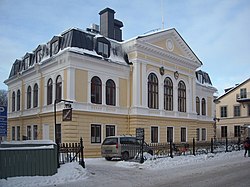
Up until June 2010, students at Uppsala University were obliged to become members of one of the
The current thirteen nations all have a history stretching back to the early-to-mid 17th century, but some of them are the result of mergers of older, smaller nations that took place in the early 19th century to facilitate the financing of building projects.
The nations at Uppsala University are:
Since the 1960s there is a fourteenth nation, the Skånelandens nation (referring to the
The Uppsala Student Union was founded in 1849 as a corporation representing all students, irrespective of nation. The pharmaceutical institute became integrated in Uppsala university during 1968 and formed the Faculty of Pharmacy at Uppsala University, and the pharmaceutical educations moved to Uppsala university during 1972. At the same time, the Pharmaceutical Student Union (Pharmaceutical Association of Uppsala Students) became a Student Union at Uppsala University. The students at the faculty of Pharmacy were also exempt from compulsory membership in the nations, but most pharmacy students belonged to one. However, they were obliged to take up membership in the Pharmaceutical Student Union, an organisation having the same role as the nations and Uppsala Student union at the rest of the university.
The compulsory membership in a student union was abolished on 1 July 2010; however, the unions will still be representing organisations in the university boards and committees. The status as a student union will be decided upon by the university board for periods of three years at a time. On 20 February 2013, the university board decided that there will be four student unions at the university from July 2013 – June 2016: the Uppsala Student Union (for students at the faculties of Art, Social Sciences, Languages, Theology, Law, Educational Sciences and Medicine), the Pharmaceutical Student Union (for students at the Faculty of Pharmacy), the Uppsala Union of Engineering and Science Students (at the Faculty of Science and Technology), and Rindi (the union for students at Campus Gotland).[21] In February 2016, two additional associations were given the status as student unions: Uppsala Business & Economics Students Association (for students of economics) and Uppsala Law Student Associations (for students of law).[22] Thus, there are now six student unions at Uppsala university.[23]
Music
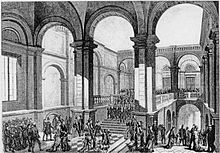
The University's Royal Academic Orchestra was founded in 1627. Its main purpose is to play at academic ceremonies but holds concerts on other occasions as well. Its leader has the title of director musices. The position has been held by composers such as Wilhelm Stenhammar, Hugo Alfvén and Lars-Erik Larsson. Affiliated with the university are three choirs, the mixed Uppsala University Choir (Allmänna Sången), founded in 1830, the male choir Orphei Drängar, founded in 1853, and the Academy Chamber Choir of Uppsala, founded in 1957. A number of other choirs and orchestras are affiliated with the nations.
An important name in the recent history of the choirs is Eric Ericson, who was the conductor of both Orphei Drängar and the Chamber Choir. In honour of Ericson, the FöreningsSparbanken endowed the Eric Ericson Chair in Choral Directing, and the Uppsala University Choral Centre was inaugurated in 2000. The centre arranges courses in choral directing. Uppsala universitets Körcentrum
Housing crisis
Like many cities, there is a shortage of housing in Uppsala, a problem which has existed for many years. Both native Swedes and foreign students are finding it difficult to find accommodation when first enrolling on the university.[24][25] This problem is however not as bad as it was with several major housing construction projects having been completed after 2010.[citation needed]
There has never been a custom in Sweden for the universities to arrange housing for students, in fact, universities are by law not allowed to own housing. Students are expected to set their own living accommodations on the private market. To make it easier for students to find moderately priced housing, special student rooms and student apartments have been built by the student nations and student unions. However, the student housing is insufficient to accommodate all students. About 40,000 students are eligible to live in the 11,000 available rooms and apartments.[26] Because of the low rent in these apartments and the general lack of housing in Uppsala the student apartments are highly attractive and many try to hold on to the contracts as long as possible even after graduating.[27]
Housing
Some of the most popular housing accommodations for students are Flogsta, Kantorsgatan, Studentstaden, Studentvägen, Klostergatan, Rackarbergsgatan and many more.
Flogsta is one of the international students' biggest and most popular housing choices.
Athletics
Sports play a very small role in the life of the university, compared to British and especially U.S. universities, but have existed in various forms since the early 17th century. Uppsala University is more noted for its musical and choral traditions. Both have partial roots in the 17th-century institution of extracurricular exercises for students from the nobility.
The exercitiae
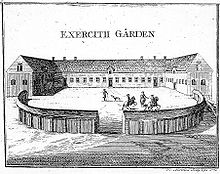
To ease the recruitment of students from the nobility, the university started in the 1630s to offer training in a number of exercitiae or "exercises" (Swedish: exercitier) deemed necessary for the well-rounded education of a young nobleman:
- Fencing – Arranged in collaboration with Upsala Fäktning, a private fencing club.[28]
- Gymnastics and sports – Located at the Art Nouveau University Gymnastics Hall, colloquially known as Svettis (from the sweat)
- Riding – Arranged by the equestrian department of the University, which has its own stables. Leaders of the activities are the Academy Stable Master and the Inspector Equitandi
- Music – Leader of the musical activities is the director musices, who is the conductor of the Royal Academic Orchestra; the current Director Musices is Professor Stefan Karpe
- Drawing – The university appoints an established artist as Drawing Master; free weekly croquis and other lessons are offered in the southern tower of Uppsala Castle
Other sports
Besides the exercitiae, other sports have had a presence in Uppsala student life. The Upsala Simsällskap, "Uppsala Swimming Society," which is the oldest swimming club in the world, was founded in 1796 by the mathematician Jöns Svanberg. It had no formal connection to the university, but all its earliest members came from academic life. Svanberg even arranged a mock graduation ceremony, a simpromotion, in a parody of the university ceremonies, where those who had graduated from its swimming training were awarded "degrees" of master (magister) and bachelor (kandidat). These degrees stuck, and Swedish swimming schools still use these degrees for different levels of swimming skills.
An attempt was made in the 1870s to introduce academic rowing after the
Rankings
| University rankings | |
|---|---|
| Global – Overall | |
| ARWU World[29] | 82 (2023) |
| CWUR World[30] | 88 (2021–22) |
| CWTS World[31] | 136 (2021) |
| QS World[32] | 105 (2024) |
| THE World[33] | 140 (2024) |
| USNWR Global[34] | 113 (2022) |
Overall Rankings
Uppsala University is one of the most prominent
Times Higher Education ranked Uppsala the 126–150th most reputable university worldwide in 2022 and the 68th most international university in the world in 2023.[37]
Rankings by subject/area
QS Rankings by Subject 2023:[38]
| Subject (only top100 are listed) | Uppsala's world rank |
|---|---|
| Pharmacy & Pharmacology | 24 |
| Biological Sciences | 52 |
| Life Sciences & Medicine | 77 |
| Environmental Sciences | 80 |
| Chemistry | 83 |
| Sociology | 91 |
| Geography | 51–100 |
| Politics | 51–100 |
| Nursing | 51–100 |
| Archeology | 51–100 |
| Development Studies | 51–100 |
| History | 51–100 |
| Theology, Divinity, and Religious Studies | 51–100 |
QS Rankings by Broad Subject Area 2023:
| Broad Subject Area | Uppsala's world rank |
|---|---|
| Life Sciences & Medicine | 77 |
| Natural Sciences | 120 |
| Arts and Humanities | 151 |
| Social Sciences & Management | 216 |
| Engineering & Technology | 237 |
Times Higher Education Rankings by Subject 2023:
| Subject | Uppsala's world rank |
|---|---|
| Life Sciences | 52 |
| Social Sciences | 101–125 |
| Arts & Humanities | 101–125 |
| Physical Sciences | 126–150 |
| Clinical, Pre-clinical & Health | 126–150 |
| Business and Economics | 251–300 |
| Engineering & Technology | 301–400 |
Notable people
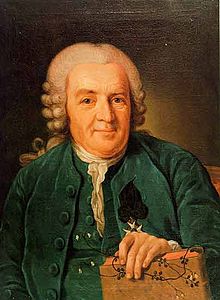
Uppsala University is associated with 8 Nobel Prize laureates,[39] and numerous royalty, academics and public figures.
As the dominant academic institution in Sweden for several centuries, Uppsala University has educated a large proportion of Swedish politicians and civil servants ever since its first period of expansion in the early part of the 17th century. These range from Chancellor of the Realm (rikskansler)
Most Swedish clergymen, including most bishops and archbishops, have been educated at the university, including, in more recent times, Nathan Söderblom (1866–1931), Professor of the History of Religions in the Faculty of Theology, later Archbishop of Uppsala, and awarded the Nobel Peace Prize in 1930 for his work as leader of the ecumenical movement.
The university became prominent in the sciences in the 18th century with names such as the physician and botanist
Many well-known Swedish writers have studied in Uppsala:
International cooperation
Uppsala University has signed student exchange agreements with about 400 universities across all parts of the world.
In May 2010 Uppsala joined the Matariki Network of Universities (MNU) together with Dartmouth College (USA), Durham University (UK), Queen's University (Canada), University of Otago (New Zealand), University of Tübingen (Germany), and University of Western Australia (Australia).[41]
In fiction and popular culture
Along with Lund, Uppsala is the historic and traditional centre of Swedish academic life, making it a popular object of reference in Swedish literature, art, and film. Specifically, Uppsala University has appeared notably in Män som hatar kvinnor or The Girl with the Dragon Tattoo by Stieg Larsson.
The Norwegian pop singer Kirsti Sparboe dedicated one of her biggest successes to Uppsala University, publishing in 1969 the song "Ein Student aus Uppsala".[42] The song, originally written in German, lasted 14 weeks in the German charts.
Uppsala University appears as a research centre in the strategy game Empire: Total War.
Uppsala University appears in the novel S. by Doug Dorst and J. J. Abrams. The fictional author V. M. Straka of Ship of Theseus sends Mr. Grahn a confidential letter on Uppsala Universitet letterhead and stamps his signature with "Straka Uppsala Arkiv" (included as an insert to the book).
See also
- List of medieval universities
- List of universities in Sweden
- Swedish University of Agricultural Sciences in Uppsala
- Johannelunds Teologiska Högskola in Uppsala
- Flogsta – student residential area in Uppsala
- Category:Uppsala University alumni
- S*, a collaboration between seven universities and the Karolinska Institutet for training in bioinformatics and genomics
References
- ^ "Uppsala University – Academic symbols". Uppsala University. Retrieved 28 June 2018.
- ^ a b c d e f "Quick facts about Uppsala University". Uppsala University. Retrieved 28 July 2021.
- ^ University Management Archived 13 January 2018 at the Wayback Machine, Uppsala University, retrieved 25 January 2021
- ^ Ridder-Symoens, Hilde de. A History of the University in Europe. Cambridge University Press, 2003. p. 84.
- ^ "Members – The Guild". The Guild. Retrieved 20 April 2017.
- ^ "Uppsala University in International Rankings". Uppsala University. Retrieved 20 April 2017.
- ^ "Shanghai Ranking-Universities". shanghairanking.com. Retrieved 23 July 2021.
- ^ "University | Ranking Web of Universities: Webometrics ranks 30000 institutions". webometrics.info. Retrieved 23 July 2021.
- ^ a b Sten Lindroth. A History of Uppsala University: 1477–1977. Almqvist & Wiksell International (1976).
- ^ UU, Webbredaktionen. "History – Uppsala University, Sweden". www.uu.se. Retrieved 10 March 2023.
- ^ "Uppsala University | university, Uppsala, Sweden | Britannica". www.britannica.com. Retrieved 10 March 2023.
- ^ Naylor, David. "The history of Uppsala University – a brief summary – Uppsala University, Sweden". www.uu.se. Retrieved 10 March 2023.
- ^ Naylor, David. "The history of Uppsala University – a brief summary – Uppsala University, Sweden". www.uu.se. Retrieved 10 March 2023.
- ^ www
.uu .se /en /disciplinary-domain - ^ www
.uu .se /en /faculty - ^ universitet, Juridiska fakulteten | Uppsala. "Om fakulteten". jur.uu.se. Archived from the original on 4 November 2016. Retrieved 4 November 2016.
- ^ "Forum for South Asia Studies". Uppsala Universitet. Archived from the original on 2 February 2014. Retrieved 21 January 2014.
- ^ The Svedberg Laboratory main page Archived 18 June 2012 at the Wayback Machine. Retrieved July 2012
- ^ The Svedberg Laboratory, proton therapy page Archived 24 April 2012 at the Wayback Machine. Retrieved July 2012
- ^ "News & Articles". NAPT.
- ^ Waara, Anneli. "Studentkårer utsedda av konsistoriet – Uppsala universitet". uu.se.
- ^ Lille, Lotta (22 February 1916). "Två nya studentkårer i Uppsala – Upsala Nya Tidning". unt.se (in Swedish). Retrieved 22 October 2020.
- ^ "Student unions – Uppsala University, Sweden". uu.se. Retrieved 22 October 2020.
- ^ "Student housing shortage worse than ever". Retrieved 3 October 2010.
- ^ "Homeless in Uppsala: a foreign student's tale". Retrieved 3 October 2010.
- ^ "Tufft att hitta studentboende". Retrieved 22 February 2012.
- ^ "Hårdare bostadskontroller". Retrieved 3 April 2014.
- ^ "Upsala Fäktning". Upsala Fäktning.
- ^ "Academic Ranking of World Universities 2023". shanghairanking.com.
- ^ "World University Rankings 2021–2022". Center for World University Rankingsg. Retrieved 15 February 2022.
- ^ (CWTS), Centre for Science and Technology Studies. "CWTS Leiden Ranking 2021". CWTS Leiden Ranking. Retrieved 15 February 2022.
- ^ "QS World University Rankings 2022". Top Universities.
- ^ "World University Rankings 2023". Times Higher Education (THE). Retrieved 20 July 2023.
- ^ "U.S. News Education: Best Global Universities 2022".
- ^ "QS Top Universities: Schools". Archived from the original on 19 July 2008.
- ^ "Uppsala University – Academic Ranking of World Universities – 2018 – Shanghai Ranking – 2018". shanghairanking.com.
- ^ "Most international universities in the world". Student. 28 January 2021. Retrieved 26 July 2021.
- ^ "Uppsala University". Top Universities. Retrieved 26 July 2021.
- ^ "Eight Nobel laureates have been connected with the Uppsala University". Archived from the original on 20 June 2010. Retrieved 12 June 2010.
- ^ "Uppsala University international office (Swedish)". Archived from the original on 28 March 2010. Retrieved 24 June 2010.
- ^ "Matariki Network of Universities: Home". Matariki Network.
- ^ Eduard Fritzler (17 August 2008). "Kirsti – Ein Student aus Uppsala (mit Text und High Quali)". Archived from the original on 11 December 2021 – via YouTube.
Further reading
- Lindroth, Sten. A History of Uppsala University 1477–1977 (Almqvist & Wiksell 1976). ISBN 978-91-506-0081-0.
External links
- Official website (in Swedish)
- Uppsala University Student page (in Swedish)
- THE Rankings – Uppsala University (2008)
- Study Abroad Uppsala – A guide for international students attending Uppsala University
- American Friends of Uppsala University
